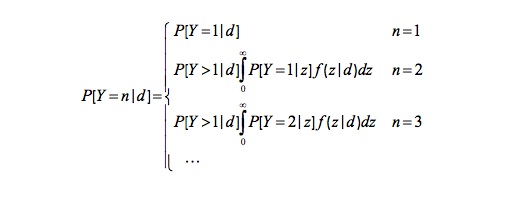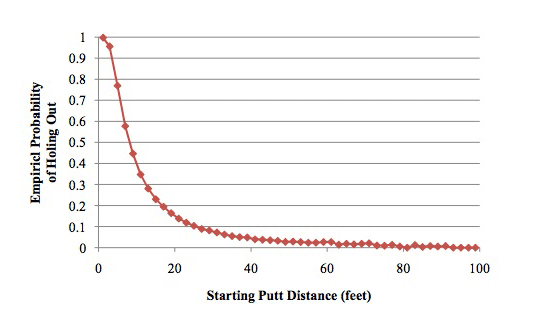The Dark Art of Putting
A new stat sheds light on golf's most mystical skill.
This series is available as an e-book for the Kindle. Download it today.

The green is golf's great stage. It's the place where the pros seem the most mortal, the most like us. They misread the breaks. They yip five-foot putts. They even four-putt in excruciating fashion. On the green, the pros can't really do anything special to the ball that an ordinary golfer couldn't do. Perhaps that's why golf announcers are at their most wide-eyed when talking over a putt. They'll tell us the putt's distance and then head for the self-help aisle and start talking about "mojo" and "attitude" and "momentum."
The players themselves are also in awe of putting. In an interview on an NYC rooftop with golf writer Stephanie Wei, alterna-pro golfer Ryan Moore breaks down the PGA Tour this way: "Really, when it comes down to golf, at this level, I mean, it really comes down to putting. As much as we all kind of want to complain about our ball striking, you know, that just distracts us from our putting … and that's probably really the reason we're not playing that good."
Putting, we're told, is a dark art of willpower and focus. But putting has accrued such mystique in large part because the stats are a mess. On Tuesday, I explained how Mark Broadie's shot value allows us to precisely measure how much putting or driving contribute to a player's score. A team from MIT has built on Broadie's work by developing a new putting stat for the PGA Tour called "putts gained per round." It's similar to Broadie's shot value but makes a few different decisions in how to set a benchmark putting standard for pro golfers. Putts gained per round is likely to be the stat that brings "moneygolf" to the masses—if all goes according to plan, it should be part of golf's television broadcasts starting next season.
Since the time of shepherds and brassies, prowess on the greens has been judged by the number of putts a player takes per round. That's fine as a rough guide, but it's easy to see where the stat falls short. Yes, a player with a low number of putts per round may be holing an absurd amount of putts. Or maybe he's missing a lot of greens, chipping it close, and knocking in a bunch of easy two-footers that anyone could make.
In order to get around this "missed green" problem, the PGA Tour has a related stat called putting average, which counts the number of putts taken on greens that a player hits in regulation. (That means landing the ball on the green with a chance to make birdie or better.) But putting average isn't precise either. If you consistently hit great iron shots, you'll land the ball closer to the hole, and you'll subsequently make more putts. The player who lands the ball farther away from the hole but is a world-beating putter will be hidden by the statistics. He's better on the greens, but you don't know it.
With ShotLink, the building blocks for an accurate putting statistic are almost right in front of us. ShotLink has the key pieces of information: where millions of putts started, where millions of putts ended up. But determining putting skill from these data requires some mathematical gymnastics. To that end, the Tour approached the MIT mathematicians, led by Douglas Fearing, and asked them to analyze the stats.
They came back with many equations. Here is what the equation for putting looks like:

OK, let's back up a moment. Fearing and his colleagues Jason Acimovic and Stephen Graves wrote up that equation as part of a 2010 paper titled "How To Catch a Tiger: Understanding Putting Performance on the PGA Tour."
How did they figure out how putting works? The first step was to take the ShotLink data and figure out the probability of making a putt from five feet, 10 feet, and so on. Lots of researchers have done this (including the Brits in Search for a Perfect Swing), and the shape of the curve hasn't changed much over the years.

The closer you are to the hole, the more putts you make. These days, pros make 50 percent of their putts from eight feet and 20 percent of their putts from 16 feet. Then the curve flattens out: They make very few putts longer than 40 feet.
Next, the researchers looked at missed putts: How far does the ball stop from the hole? Getting the data to behave requires using "gamma regression," but the answer is what you'd expect: The longer the original putt, the longer the average distance of the subsequent stroke. With these two pieces of data, the MIT team had the foundation it needed to figure out a "putts-to-go" number for every point on a green.
So far, so good. But as golf buffs know, there are lots more variables to consider. Conventional wisdom holds that golfers who consistently land the ball downhill from the hole will leave themselves easier uphill putts. Wouldn't their great approach shots, then, give their putting stats an unnatural boost? Actually, the data shows that whether you are uphill or downhill from the hole is statistically insignificant. Fearing and Acimovic told me their most striking discovery was just how dominant a factor distance is when it comes to making putts. In their opinion, just two other factors have a significant impact.
The first is that elite golfers play the most prestigious tournaments, which typically have the fastest, most-difficult greens. The guys who qualify for the Masters, for example, usually see their putting rankings take a dip on account of Augusta's bewitching putting surfaces. On the other side, if you play a lot of courses with slow, level greens, you are going to look like a better putter than you are.
To correct for this bias, the MIT team adjusted its model. It figured out whether a particular green on a particular course was "easy" or "difficult" by looking at all of the putts taken on that green. But that presents an additional complication: A green could be "difficult" because the players in that tournament just weren't very good putters. Fearing and Co. thus also factored in the overall quality of the putting skill in the field. Once the computational dust settles, the model can distinguish between the value of sinking a putt from 12 feet on an "easy" green and the value of sinking a 12-foot putt on a "difficult" green.
The result, happily, is a list. The poster boy for the difference between MIT's putts-gained-per-round rankings and the standard stats is Ernie Els. From 2003 to 2008, the South African star ranked 15th in the PGA Tour's putting average. During that same period, he ranked 283rd in putts gained per round—his -0.63 mark means he gave back six-tenths of a stroke to the field each 18 holes with his substandard putting.
In this case, the putts gained per round stat matches what golf fans see with their eyes: Els is a wonderful iron player but a poor putter. The reason Els' putting average is so strong, the MIT team explains, is that—on account of his great iron shots—his "first putt" distance is two feet shorter than the average pro. Putts gained per round strips away those approach shots and reveals the truth: Ernie Els is an elite player despite his putting, not because of it.
The MIT study also confirms a fact that, until this year, was a given in golf statistics: the ridiculous dominance of Tiger Woods. From 2003 to 2008, he ranked first in both putting average and putts gained, bettering the field by seven-tenths of a stroke per round with his putting alone. To put that in perspective, if Tiger was paired with Ernie Els, Ernie would give up almost a stroke and a half to Tiger on the greens.
But the real star here is the putts-gained-per-round model. It has great flexibility, allowing us to evaluate a golfer's aptitude on the greens over a career, a year, or a tournament. It can also tell us, in real time, Tiger's expected putts to go from the back of the 17th green. Putts gained per round, then, will be the best possible test case for the new golf statistics: If it doesn't catch on with fans and players, nothing will.
The latest research has also revealed that putting is less important than it's made out to be. Ryan Moore, it turns out, is wrong about the key to winning on the PGA Tour—it doesn't really all come down to putting. In my next piece, I'll explain why the line "Drive for show, putt for dough" doesn't hold up to statistical scrutiny. A more accurate take on the old cliché: "Drive for dough, putt at least so-so."
Next: Luck vs. Skill
To hear Michael Agger, Josh Levin, Mike Pesca, and Hanna Rosin discuss Agger's "Moneygolf" series, click the arrow on the audio player below and fast-forward to the 16:35 mark:
You can also download the podcast, or you can subscribe to the weekly Hang Up and Listen podcast feed in iTunes.
Like Slate on Facebook. Follow us on Twitter.